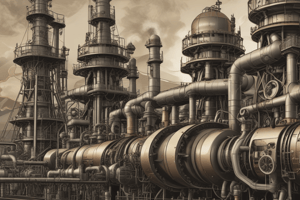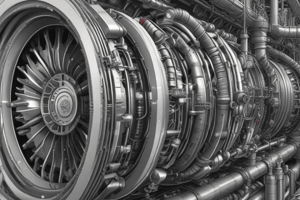Podcast
Questions and Answers
Why are steam-tight glands necessary on turbine shafts?
Why are steam-tight glands necessary on turbine shafts?
- To increase the flow of steam from the steam space along the shaft
- To minimize corrosion on the turbine shaft
- To allow steam to escape to the atmosphere
- To prevent steam leakage along the shaft (correct)
What is the purpose of carbon segments in the sealing rings?
What is the purpose of carbon segments in the sealing rings?
- To minimize corrosion in the casing grooves
- To lubricate the turbine shaft
- To increase steam pressure on the turbine shaft
- To prevent steam leakage around the outside of the ring (correct)
What is the function of the garter spring in the carbon sealing rings?
What is the function of the garter spring in the carbon sealing rings?
- To increase radial movement of the packing
- To restrict steam flow to atmosphere
- To prevent steam leakage through the shaft openings
- To hold the assembled segments together and to keep them on the shaft (correct)
Why are labyrinth glands used in high output machines operating with high temperature and high-pressure steam?
Why are labyrinth glands used in high output machines operating with high temperature and high-pressure steam?
What is the purpose of keeping a narrow clearance between the turbine shaft and casing in labyrinth glands?
What is the purpose of keeping a narrow clearance between the turbine shaft and casing in labyrinth glands?
Flashcards are hidden until you start studying
Study Notes
Lubrication System
- Excess lubricating oil is supplied to turbine bearings to carry away heat conducted from the steam space and maintain safe working temperatures.
- The lubricating oil system is driven by a gear-driven oil pump from the main turbine shaft, supplying oil under pressure for positive bearing lubrication.
Oil Flow Path
- High-pressure oil from the oil pump branches off to the governing system for turbine speed regulation.
- The oil then passes through a relief valve to prevent overpressure, and then through an oil cooler to reduce its temperature.
- The oil pressure is reduced by a pressure reducing valve (PRV) to a suitable level for bearing lubrication.
- The lubricating oil then feeds through both high-pressure (H-P) and low-pressure (L-P) bearings before returning to the oil tank.
Carbon Sealing Rings
- Small turbines use carbon sealing rings for shaft sealing, as shown in Figure 3.
- Segmental carbon sealing rings are used for steam glands on the turbine shaft, as shown in Figure 7.
Studying That Suits You
Use AI to generate personalized quizzes and flashcards to suit your learning preferences.



